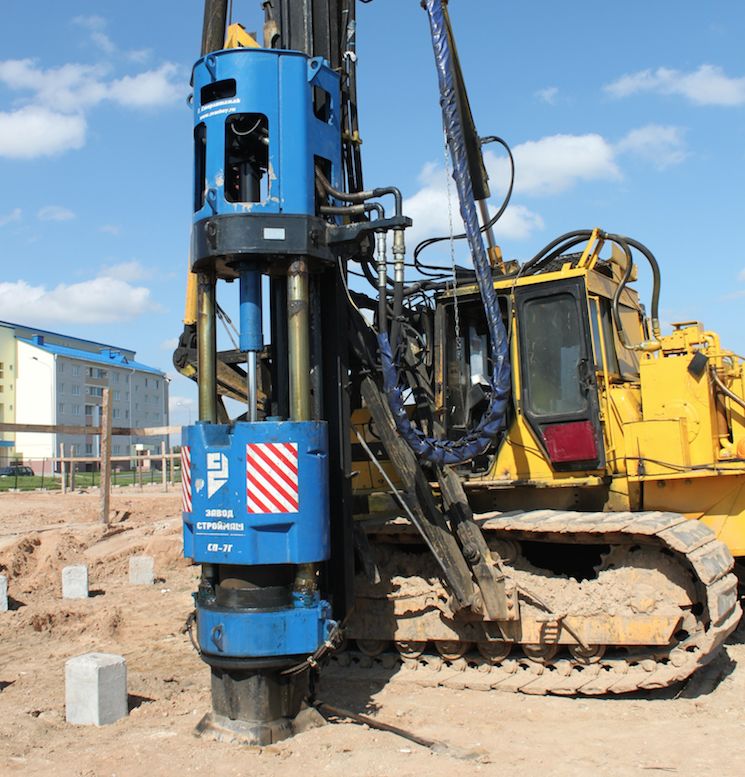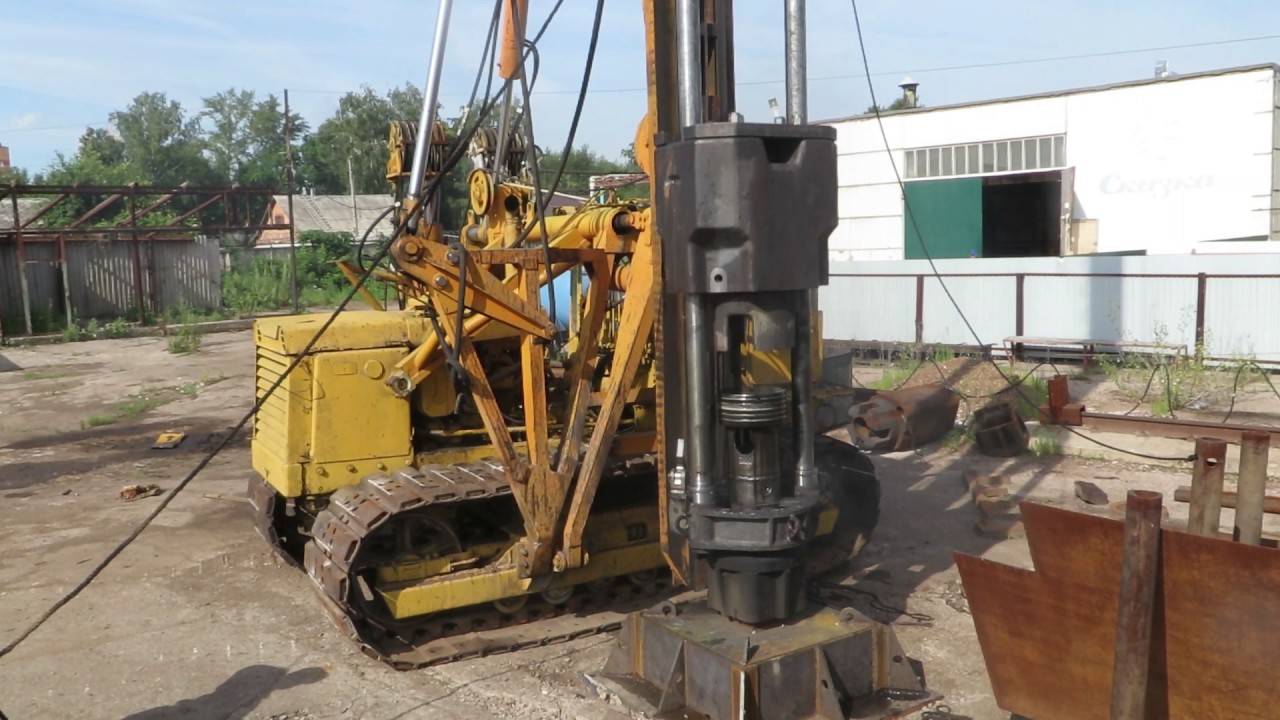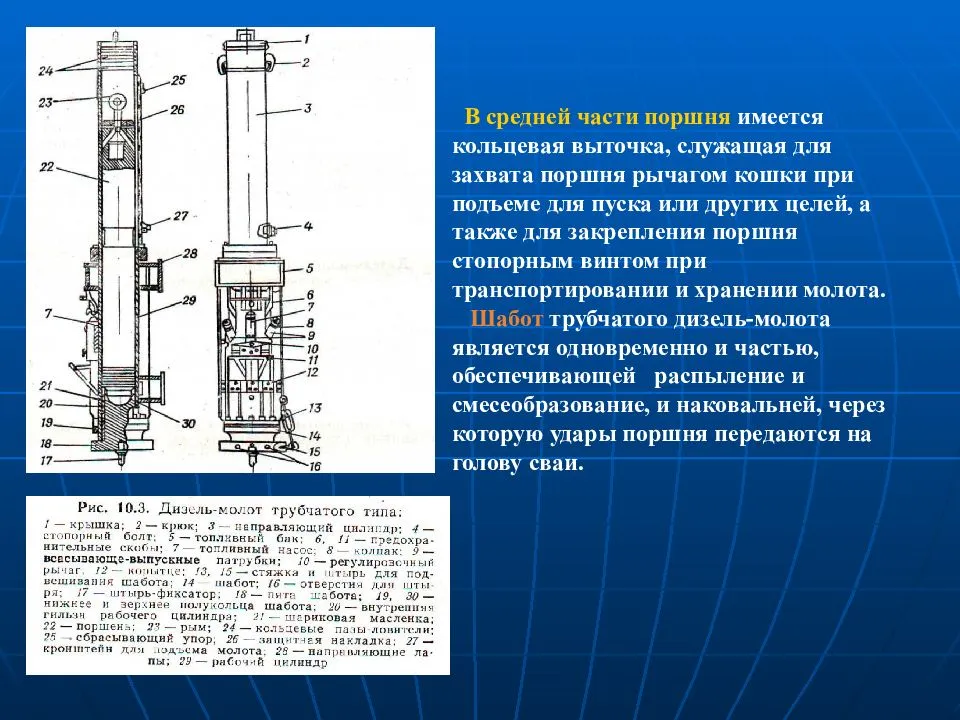Pile driving technology with a tubular device
The sequence of work with this type of unit is as follows:
- the first stage is the docking of the piston part with the cat, after which they rise to the upper position with the help of a copra winch;
- after that, in automatic mode, this part and the cat are undocked, as a result of which the striking part falls along the guide;
- while the fall process is taking place, a pump is switched on, which begins to gradually pump diesel fuel into a special recess located in the upper part of the shabot body;
- during the lowering of the piston, the process of air compression inside the hammer tube also occurs;
- when the piston strikes the sabot, the fuel detonates, in which part of the energy is spent on lifting the hammer back, and the other on driving the pile into the ground.
In other words, the immersion and operation of the diesel hammer occurs due to the impact of impact energy and gas-dynamic energy that occurs during the detonation of the fuel.
Features of use
The hydraulic hammer is an attachment and for its operation it is necessary to install (pile driver) on a wheeled or tracked chassis, equipped with an outrigger boom. Wheeled pile drivers are made on the basis of four-wheel drive heavy trucks, tracked ones - on the basis of excavators, tractors or cranes.
When immersing steel and reinforced concrete piles, a cap is used to protect the upper part of the pile from being destroyed by a hammer; when driving wood piles, the pile head is protected with a cylindrical ring made of strip steel.
The mass and dimensions of the piles to be driven determine three parameters of the pile driver:
- boom lifting capacity;
- useful mast height;
- hammer power.
The functionality of the pile driver depends on the availability of a tilt and boom adjustment mechanism. Universal and semi-universal pile drivers allow you to drive piles at an angle, simple pile drivers have a fixed mast.
The hammer is a highly loaded mechanism that is subject to wear and tear. When buying or renting a device, the availability of consumables, their price and repair base are important. If a supplier has been present on the sales market for a long time, has a service network and highly qualified specialists, then this will be an advantage when choosing.
Rod type hammer operation
As in the previous case, the work of driving a pile with a hammer of this type takes place in several stages. By the way, the price of a diesel hammer of this type starts from 80 thousand rubles and can reach 1 million rubles or more.
- To begin with, the process of slinging and fixing the pile in the right place goes through. After that, the "cat" is fixed on the pile driver winch. Then it goes down and engages with the striking part of the structure.
- The next step is to lift the cat and striker to their highest position.
- When the lift is complete, the operator activates the release lever. At this moment, the striking part is released and, under its own weight, falls down towards the hinged head, which is fixed on the pile post.
- When the firing pin is lowered, the air inside the cylinder is compressed and heats up to a temperature of 650 degrees.
- At the moment the hammer strikes the articulated head, the pump pumps diesel fuel into the compressed air chamber.
- During the impact, the fuel self-ignites. The gas that is released at the moment of detonation throws the shock part back up.
- Naturally, during the ascent, the speed will rapidly decrease due to the weight of the striker. When the energy is completely depleted, the detail will rush down again.This circular process will continue until the operator turns off the diesel pump.
Device and principle of operation
The design of a diesel hammer includes the following elements:
- piston block;
- shock or working part;
- pump;
- hinge support.
In turn, the drum part also contains additional elements. Its design includes a cylinder, a fuel tank and "crampons".
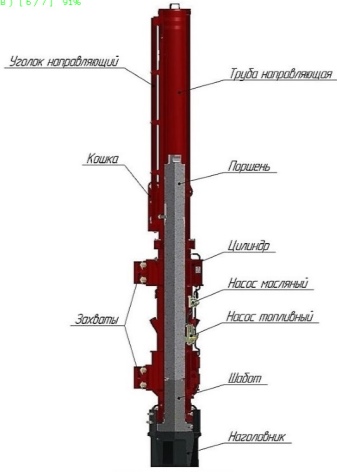

With the help of the latter, the hammer is suspended on the drift cables. The hammer frame is assembled from guides located in a vertical plane. They are usually connected with a headrest from the bottom to ensure the rigidity of the structure. The upper part of the hammer is considered to be impact, and it moves freely.
The headrest of the structure contains a piston, at the expense of which movement of the structure. The principle of the hammer is not as complicated as it might seem. The blow to the headgear occurs after the cylinder can be raised to the stop, where the traverse is located, and then abruptly lower it. It should be noted that at the time of ascent, the air is compressed, due to which the temperature rises. At the same moment, a stream of liquid fuel enters it, which instantly ignites and forms gases, allowing the cylinder to rise sharply.

When the cylinder reaches the traverse and begins to move downward, the air in it will begin to compress again. Thus, when the element descends, an explosion will occur again, after which the cycle will repeat. This is how the unit works.

With its help, a timely discharge of the combustible mixture into the cylinder, which is located on the headrest, occurs. The mixture is supplied through a special fuel line, at the end of which there is a nozzle. Releasing the lever sets the injector in motion and the fuel enters the cylinder. The lever itself is located at the top of the pump structure.
It is noteworthy that the process of fuel supply is automated, and it is carried out directly by the cylinder when it falls down. This result is achieved due to the provided stop from the outside.

A device with a hook is placed between the traverse and the cylinder. It holds the cylinder in the required position. The device is fixed by means of a winch cable, due to the work of which the hammer is lifted during the installation of the equipment on the pile.


Pros and cons of the design
Despite some differences between tubular and rod devices, they have common positive and negative qualities. The benefits include the following:
- mobility;
- quite simple and very reliable design;
- energy autonomy;
- the productivity of the machines is quite high.
If we talk about the shortcomings, then there are only three of them. The first is the vibration of the ground, which occurs when struck by a hammer. During operation, a large amount of dust is generated, which makes work difficult. In addition, the detonation of diesel fuel emits a certain amount of harmful substances into the atmosphere, thereby polluting it. The price of a tubular diesel hammer starts from a higher amount - from 320 thousand rubles.
The advantage of using a hydraulic breaker
Pile driving can be done in several ways: using diesel and hydraulic hammers, pressing, drilling and installing a pile in a well, as well as using a vibratory pile driver.
The vibratory pile driver is effective when working on sands and loose soils; on more difficult soils, you have to use other equipment. The indentation technology requires high costs for the delivery of equipment to the site of work and, due to the size of the equipment used, is not suitable for small construction sites. Driving piles using leader drilling is used in conditions where driven piles cannot be used due to geological conditions.
When comparing a diesel hammer and a hydraulic hammer, most manufacturers choose the latter.And there are reasons for this: if a pile-driving diesel hammer strikes with almost the same frequency, then the hydraulic drive allows you to change the impact parameters, choosing the mode required for a specific soil.
Hydraulic pile driving equipment significantly surpasses other types of pile driving equipment in terms of technical and operational parameters, which explains its growing popularity.
Thus, compared with other types of similar equipment, the hydraulic pile hammer has the following advantages:
- high performance on different soils, reliability;
- ease of operation, no exhaust gases;
- the presence of an effective forced cooling system, which allows you to work 24/7;
- the ability to adjust the parameters of the impact on the pile;
- the ability to work in cramped conditions;
- minimal seismic impact on the ground;
- long resource.
The operational advantages of the breaker are especially noticeable when driving piles under conditions of maximum resistance. On heavy soils, where the use of a diesel hammer is possible only with the help of soil erosion or leader drilling, a hydraulic hammer can load the pile without the use of additional technologies.
Diagram of a rod diesel hammer
Rice. 3. Diesel hammer type SDM (rod)
1 - piston block; 2 - shock part; 3 - guide rods; 4 - fuel tank; 5 - cat; 6 - traverse
Diesel hammer works automatically, making from 50 to 60 blows per minute. The lifting height of the hammer at idle speed is regulated by the amount of supplied fuel and ranges from 1 to 2 m.
Pile driving with a diesel hammer is carried out in the following sequence.
- The cylinder, lifted by the winch to the uppermost position, is uncoupled and falls down under its own weight;
- the air is compressed,
- fuel flares up
- and the resulting gases throw the cylinder upward.
- The gases simultaneously push the piston, increasing the sinking of the pile.
- Having reached the uppermost position, the cylinder falls down again and the hammer operation is automatically repeated until the fuel pump is turned off.
Video of tests of a sucker rod diesel hammer
In the considered design of the hammer, the cylinder is movable and is used as a striking part.
Another design of a diesel hammer has been developed, based on the reverse principle, that is, the cylinder is stationary, and a heavy movable piston serves as the impact part. Such hammers are called tubular.
Unit characteristics
If we consider the devices of a diesel hammer, then the tubular type is considered more efficient, and also has a more advanced design. If you take a hammer of the same weight of a tubular and a rod type and compare their effectiveness, you will notice that with the same weight, the tubular structure allows you to drive heavier piles. The difference in weight can be as high as two or three times. The main structural parts of these machines are:
- cylinder or rods;
- a striking part, a striker or a woman that moves inside the cylinder;
- shabot, which is the lower part of the hammer, to which the headgear is attached.
Operation of the device
There are spherical recesses on the woman and the shabot, which, when in contact, will form a fuel combustion chamber. Diesel fuel is injected into this chamber. When a woman hits the shabot, a sufficiently high pressure is created in this chamber, due to which the fuel liquid ignites spontaneously and throws the woman to its top point. After that, she falls back again. Thus, pile driving is carried out.
If we compare tubular and rod hammers, then we can say with confidence that the second type loses significantly in terms of service life. The tubular design can last about twice as long.Low service life is the main disadvantage of the rod type.

Rod diesel hammer
In fig. 3 shows a diagram of the structure and operation of a rod diesel hammer SDM. It consists of a piston unit, an impact part - a cylinder, guide rods, a fuel tank, a cat, with which the hammer is suspended from a hummock on a headframe, a traverse that determines the position of the hammer relative to the headframe arrows. The hammer is installed on the pile using a pivot bearing.
Inside the frame, consisting of vertical guide rods, which are connected from the bottom with a headrest and along the top by a traverse, the striking part of the hammer moves freely, which looks like a cylinder open at the bottom. The piston is firmly attached to the headgear.
The operating principle of a diesel hammer is as follows. If the cylinder is lifted up to the traverse and then lowered, then if it falls, it will hit the headgear. In this case, the air trapped in the cylinder will be strongly compressed, as a result of which its temperature will rise sharply. At this moment, a jet of atomized liquid fuel (diesel oil, diesel fuel, gas oil, etc.) is injected into the cylinder, which ignites, and the resulting gases throw the cylinder up to the traverse.
Falling then down, the cylinder will again compress the air, a new explosion will occur and the cycle will repeat itself.
The fuel pump, which is an important part of the hammer, as it provides an automatic supply of fuel to the cylinder at the right time, is located on the headrest and is connected to the fuel reservoir. Fuel enters the cylinder directly through a fuel line ending with a nozzle fixed in the bottom of the piston.
The required portion of fuel is supplied to the cylinder by pressing the lever located in the upper part of the pump
This operation is performed by the falling cylinder using a special stop on its outer surface.
A special device with a hook for gripping the cylinder is located between the cylinder and the upper crosshead. The device is connected to the winch cable, which lifts the entire hammer when it is installed on the driven pile, as well as the cylinder when the hammer is started.
Basic types
First of all, you need to pay attention to the fact that there are several classifications of diesel hammers. It is worth taking a closer look at two of them, since they are the most popular.
By design type
If we consider the classification by design features, then diesel hammers are divided:
- on tubular;
- rod.


The features of these types should be considered separately, depending on the type chosen.
Rod
The design contains the following elements:
- a piston that stands on a special support;
- vertical guides;
- a system for supplying a combustible mixture;
- "Cats", providing fixation of the structure in the required place.

Upon closer examination of the details, you will notice that the block is a monolithic structure.
It is cast inside the hammer body, and in the block itself, in addition to the piston, there are also compression rings, hoses through which fuel flows, and nozzles. The latter are responsible for spraying the mixture in the pump.


The block itself, as already noted, is on a hinged support. Its bottom wall holds vertical guides that allow the hammer to move during pile driving. To make the structure more rigid, it was decided to connect the guides to each other with a horizontal traverse.
When the equipment starts up, the hammer moves along the rails. It moves up and down to drive piles. Additionally, it should be noted the presence of a chamber for combustion of fuel fluid at the bottom of the body of the impact part.
Tubular
The peculiarity of the design of tubular diesel hammers is that it is completely unified and created on the basis of a tractor. In other words, the production of such equipment is carried out according to a proven and well-established scheme.

Basic structural elements.
- "Cats". They are the main equipment for fixing the hammer.The advantage of the device is the presence of an automatic mechanism that ensures the timely fixation of the element or its reset.
- Impact piston. Contains compression rings for improved performance.
- Shabot. This is a striking surface, in the process of hammer operation, in contact with the striker.
- Working part cylinder. In it, an explosion of the fuel mixture is carried out, which ensures the lifting of the hammer.
- Cooling system. Prevents equipment overheating.
- Lubrication system. Provides durability of the structure.
- Guide tube. It is made of high strength steel.


In this regard, when using equipment of the second type, it becomes necessary to organize regular breaks. This is done so that the structural elements cool naturally. If this is not foreseen, the hammer may fail.
By weight
The classification by weight of the striking part of the hammer implies the presence of three groups:
- light hammers - up to 600 kg;
- medium hammers - 600-1800 kg;
- heavy hammers - all tools weighing more than 2.5 tons.
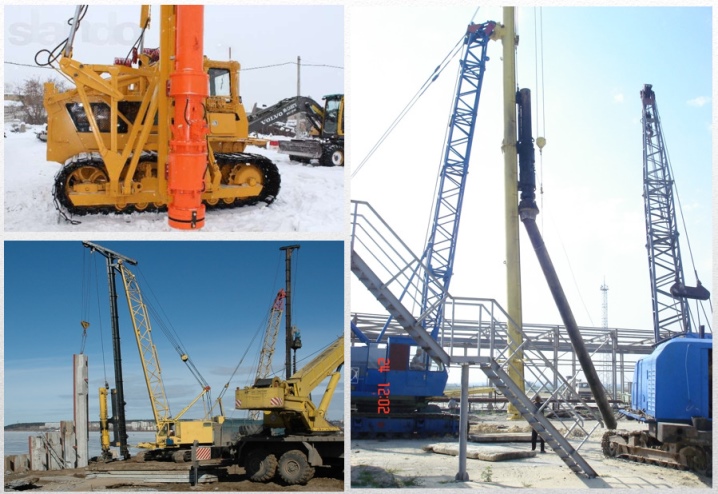
The latter are considered the most demanded at any construction site. The former are used for driving small piles in soft soils, as well as for various studies.
Models and manufacturers of Russian diesel hammers.
Modern diesel hammers allow high-quality driving of any type of pile in a variety of conditions. The main factor in this is the weight of the hammer itself, since the strength of the blows depends on this, therefore, the abbreviated name of the type is indicated when marking - rod or tubular and the mass of the impact piston in kg. Thus, all diesel pile driving hammers are abbreviated as MSDSH - rod or MSDT - pipe. The main manufacturers of this special equipment in Russia are Stroymash Plant OJSC (Sterlitamak, Bashkortostan)
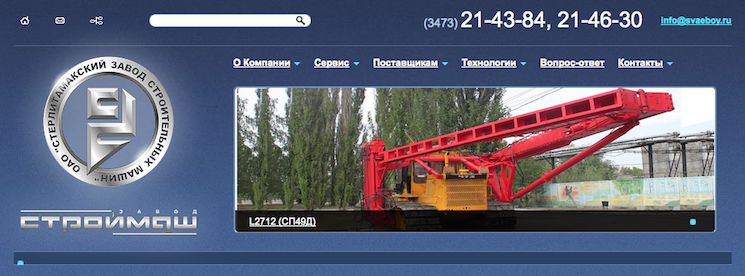
and JSC "Stroydormash" (Alapaevsk), which produce all basic models, combining them into a series of joint ventures. Each hammer of the joint venture is assigned an index indicating its type and purpose, as well as the main characteristics. The higher the index, the more massive piles and in denser soil the diesel hammer will be able to work.
There are models for rod diesel hammers:
- SP-60 - with a shock mass of 240 kg, for piles up to 0.4 tons
- SP-60A - modification of SP-60 with a striker weight of 250 kg, for piles up to 0.4 tons
- SP-4 - for piles up to 3.2 tons, weight 1250 kg
- SP-5 - 1800 kg, piles up to 3.2 tons
- SP-6V - 2500 kg, piles up to 3.2 tons
- SP-7 - 3000 kg, piles up to 4 tons
- SP-8 - 3500 kg, piles up to 4 tons
For tubular diesel hammers, the classification is as follows:
- SP-75A for piles 1.2 - 3 tons
- SP-76A for piles 1.8 - 5 tons
- SP-77A pile weight 2.5 - 6.5 tons
- SP-78A for piles from 3.5 to 8 tons
- SP-79 for piles weighing 5 - 10 tons
Here are light, medium and heavy hammers with impact weights of 1250, 1800, 2500, 3500 and 5000 kg, respectively. In addition, each model has different dimensions, which allows working with piles of different heights and thicknesses.
The diesel hammer is a production necessity.
With all kinds of construction options, diesel hammers are the most profitable alternative to other installations. The purchase of such a unit allows you to avoid many problems and save work time. Moreover, the reliability of diesel hammers allows them to be reused many times, which will pay off the costs over time. For one-time work, it is more expedient to rent a diesel hammer, while choosing the most suitable model.
Tubular diesel hammer
Tubular diesel hammers are produced with an impact part weighing from 500 to 2500 kg. The frequency of blows in them reaches 47-55 per minute.

In tubular diesel hammers, a low-pressure fuel pump is used, which is used only for metering fuel and supplying it to the combustion chamber.
The fuel is atomized by striking the piston head against the spherical cavity of the cylinder heel, where the fuel received from the pump is collected.
The main advantages of tubular hammers over rod hammers are:
- the absence of an upper traverse, which eliminates the risk of hammer breakage due to excessive lifting of the striking part, which causes an impact on the traverse;
- the presence of a low pressure pump, more durable and simpler in design and operation; s
- significantly better conditions for fuel combustion due to a more thorough cleaning of the cylinder from combustion products, carried out by natural ventilation.
Internal combustion hammers also have some disadvantages:
- large dimensions, for example, the length of a tubular diesel hammer with a striking part weighing 2,500 kg reaches 4.5 m, which complicates its operation.
- In addition, diesel hammers require qualified maintenance in order to avoid malfunctions.
In conclusion, it should be said that in very weak soils, diesel hammers work poorly, since the cylinder is thrown up so little that its fall does not provide the necessary compression of air in the combustion chamber for a flash of combustible.






